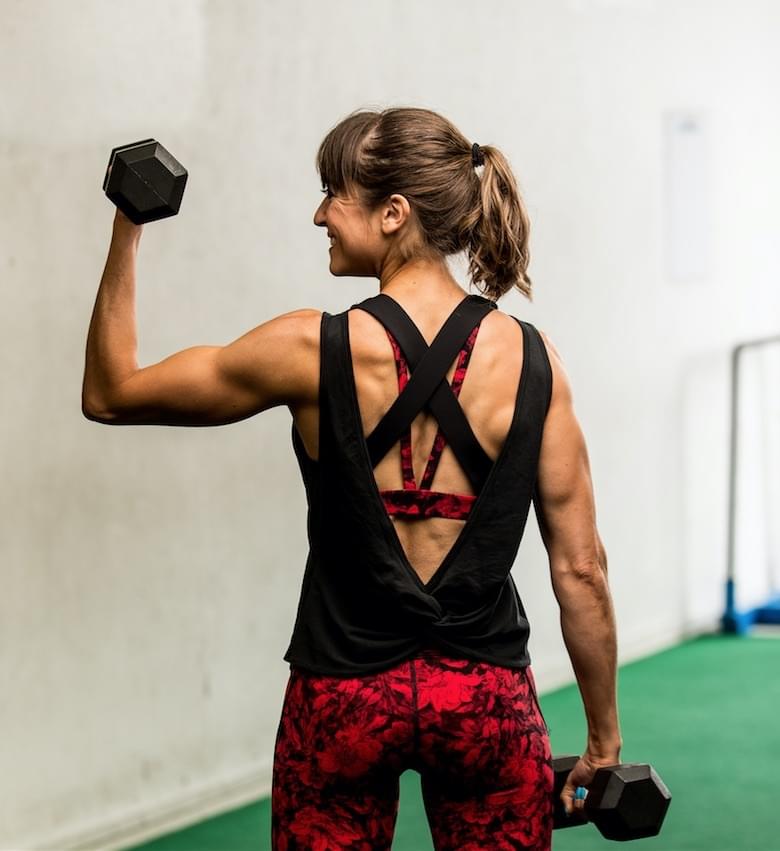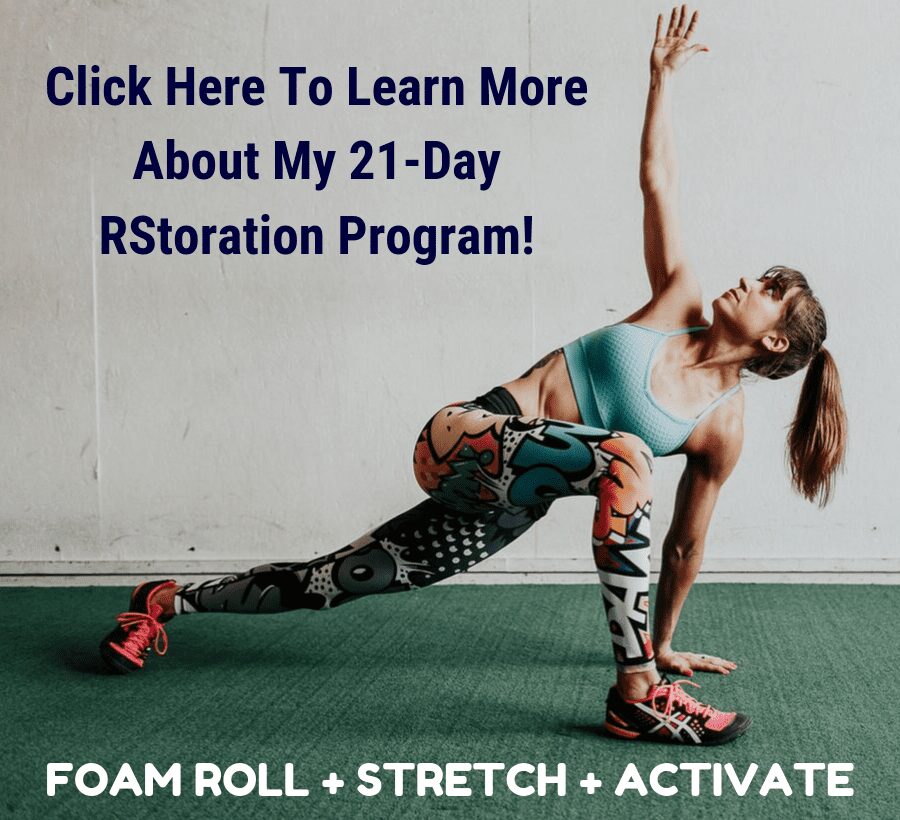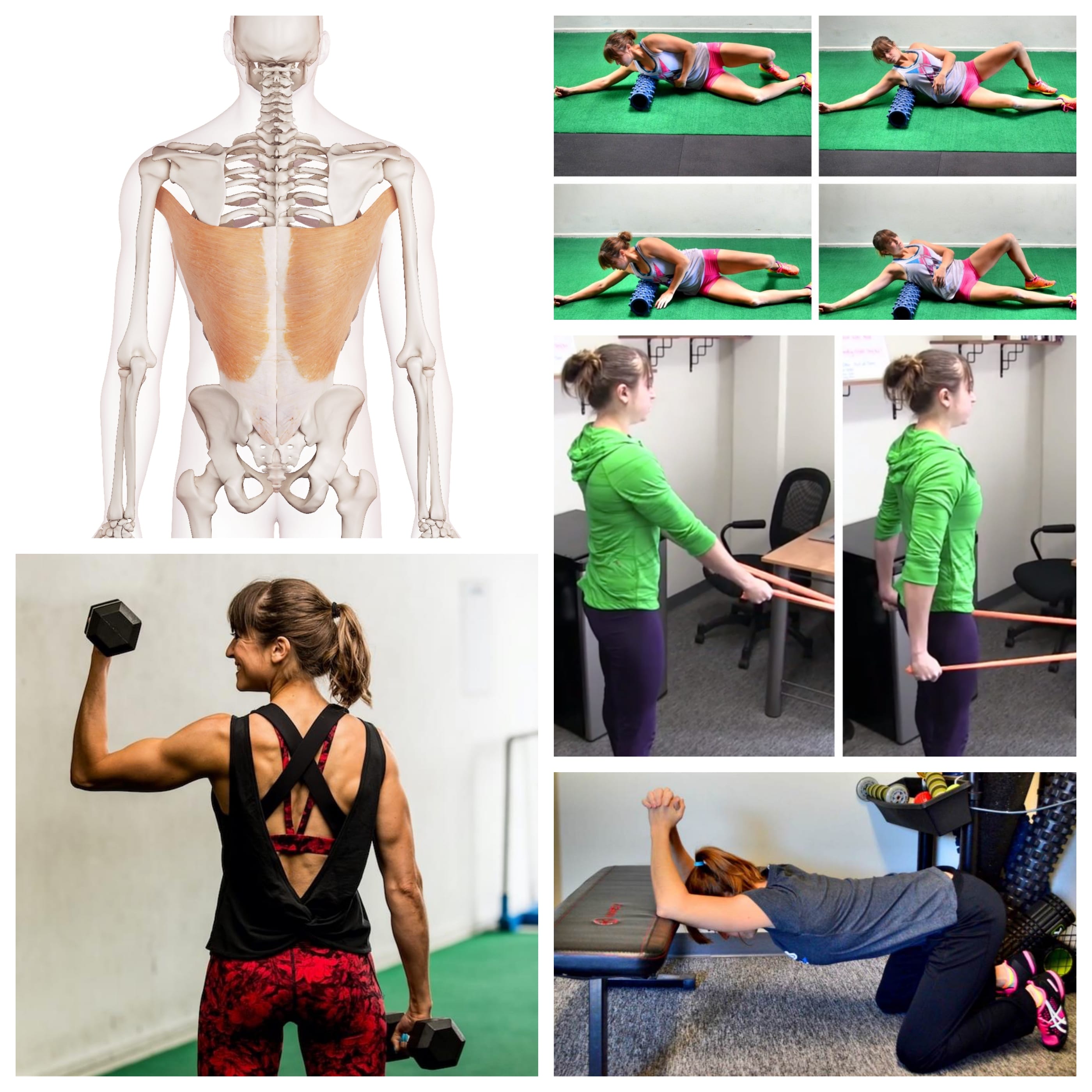
The Common “Enemy” Of Your Hips And Shoulders…
Everything is connected.
And all too often the point of pain is NOT where the problem is.
That is why, when you have aches and pains, especially nagging ones that you can’t seem to get rid of, you need to start searching further away from the point of pain.
Take for instance SHOULDER pain.
Often the first “rehab” exercises we start to include focus on shoulder mobility and strengthening of those muscles around the joint.
And this is a great place to start!
But what if, despite you doing all of the proper rehab work, things just aren’t fully getting better?
Or what if you continue to suffer from flare ups that don’t seem to be triggered by any specific upper body exercises that you can identify?
What if the actual culprit of your shoulder pain is an issue at your lumbo-pelvic-hip complex?
That’s right…what if that lower back pain or anterior pelvic tilt or SI joint issue you’ve been having is CONNECTED to your shoulder pain?!
What if your lower back, hips and shoulders have a shared “enemy”?
And what if that shared “enemy” is your LATS or the Latissimus Dorsi!
Because BOTH of these areas are affected by that one muscle.
YUP!
While we often just think of our lats as a big back muscle, playing a role in our upper body functioning, they can also affect our SI joint via their attachment to the thoracolumbar fascia and even affect the alignment of our pelvis!
So while it may seem crazy, working to correct imbalances at your hip complex could help relax tight and overactive lats and help you alleviate your shoulder aches and pains!
(BONUS…lat tightness and overactivity may be perpetuating your hip, lower back and SI joint pain so relaxing and stretching that muscle will only help!)
So how exactly are the lats a common enemy of both your hip complex AND your shoulders and what can you do to start correcting the problem?
The Lat Connection:
Ok…your lats aren’t really your enemy…
It’s almost the case of you “blame the messenger”…or the messenger becoming more involved than they should be!
Because our lats are really a bridge between our upper and lower body.

They play a role in stabilizing our shoulders, scapulae (shoulder blades), lumbar spine, sacroiliac joint (SI joint through the thoracolumbar fascia) as well as our pelvis.
The lats have a far reaching impact and affect a TON of structures and movements!
They are a bridge that can perpetuate distortions and compensations from one hemisphere to the other.
They can become tight and overactive due to other muscular imbalances and weaknesses and then lead to aches and pains in the other region.
And for this reason they can be a common “enemy” of both our upper body and lumbo-pelvic-hip complex and SI joint.
Of course the real “enemy” is our rounded-shoulder, flexed posture created by sitting hunched over our technology for 9 hours a day.
A posture that leads to muscles, like the lats becoming tight and overactive, and muscles, like our glutes, becoming underactive.
Underactive glutes can lead to anterior pelvic tilt, hip hikes (if one side is underactive especially) and tight, overactive lats that perpetuate the pain and create upper body dysfunction as well.
Lat tightness can itself create a hip hike on the same side as the tight lat and anterior pelvic tilt and SI joint issues as well.
Both the glute and lat need to work together to protect us and make sure we have the proper mobility and stability.
If these muscles aren’t working well together, this distortion can show up as upper body, specifically even, shoulder aches and pains.
And the lats also can have a DIRECT impact on our shoulder health.
Tight lats can contribute to internally rotated shoulders, or that rounded shoulder posture, as well as restricted shoulder flexion aka your ability to reach overhead.
Ever wonder why you struggle to get your arms overhead to press and end up arching your lower back to compensate?
Tight lats may be part of the problem.
Tight, overactive lats can restrict proper shoulder mobility, negatively impact your shoulder stability, and even impact your scapular mobility as well (and this may be holding you back too from achieving that first full pull up not to mention a culprit of shoulder, upper back and even neck pain!)
Basically, you need to address lat tightness, both tightness of both lats and even an imbalance between the two, and then further investigate if there are distortions at your hip complex or SI joint or actually in your upper body, that may be perpetuating the tightness!
Below are three moves to help you get started making sure this “bridge” is functioning well!

3 Moves To Try Today To Improve Your Shoulder Health:
These 3 moves will start addressing lat tightness and overactivity while also working to engage them in a productive way to help alleviate and prevent shoulder aches and pains.
These are perfect moves to include as a restorative session after a long day at work or as part of your warm up for you upper body, or potentially even LOWER BODY, lifting session.
Lat Foam Rolling:
This is a great move to start relaxing tight lats, and even its partner in crime the teres major (which assists the lat with shoulder internal rotation, adduction and extension).
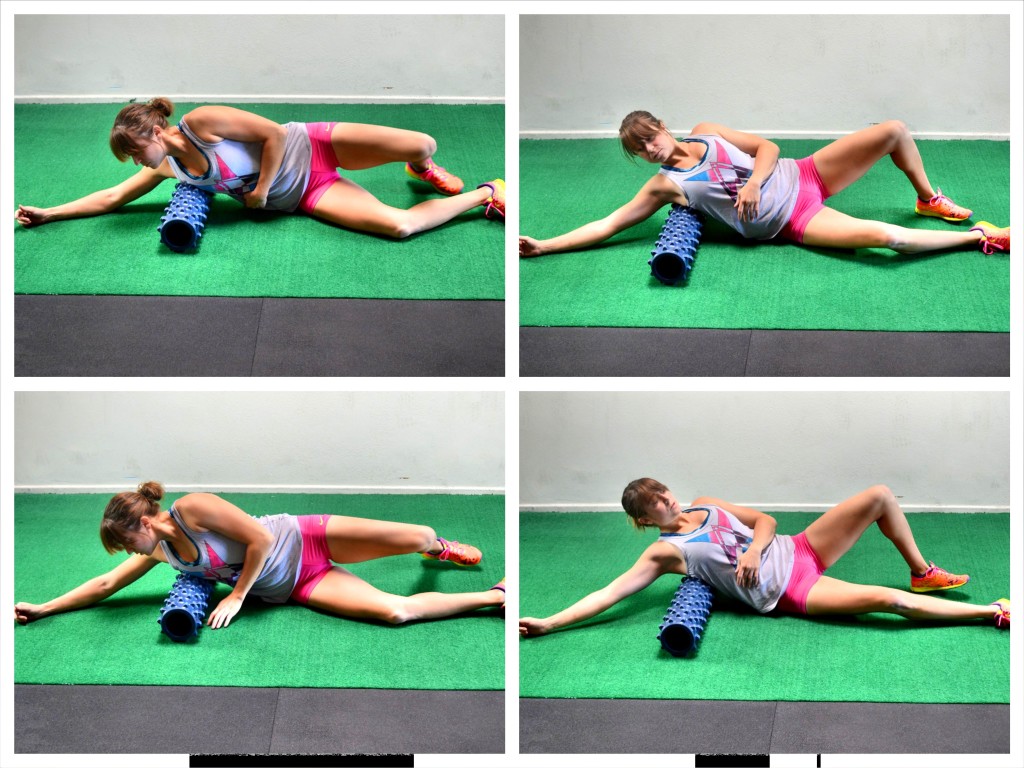
To roll out your lats a roller is best although you can use a foam ball or even a tennis ball.
Start by lying on your side with a roller under one armpit. Extend the arm on the side with the roller up above the roller. Then rock forward and backward on the roller, rotating your chest toward the ground and then up toward the ceiling as you roll on the roller so it hits toward your ribs and then toward your back.
Hold on any tight spots you find then move it lower down the side of your back. Hold on any tight spots as you go and make sure to rock forward and backward as you make your way down your side.
As you work down your side, you will want to rotate slightly more toward your back, even bringing the roller to hit under your shoulder blade.
Work all the way from your armpit to about the end of your rib cage.
Be careful when rolling lower down your back into your low back. You do not want to arch over the roller and hyperextend your low back.
Kneeling Thoracic Extension And Lat Stretch:
This is a must-do stretch if you want to stretch your lats across the expanse of the muscle while also stretching your triceps and working on your shoulder flexion and thoracic extension.
Basically, it’s a multipurpose stretch we HAVE to include if we have a desk job!
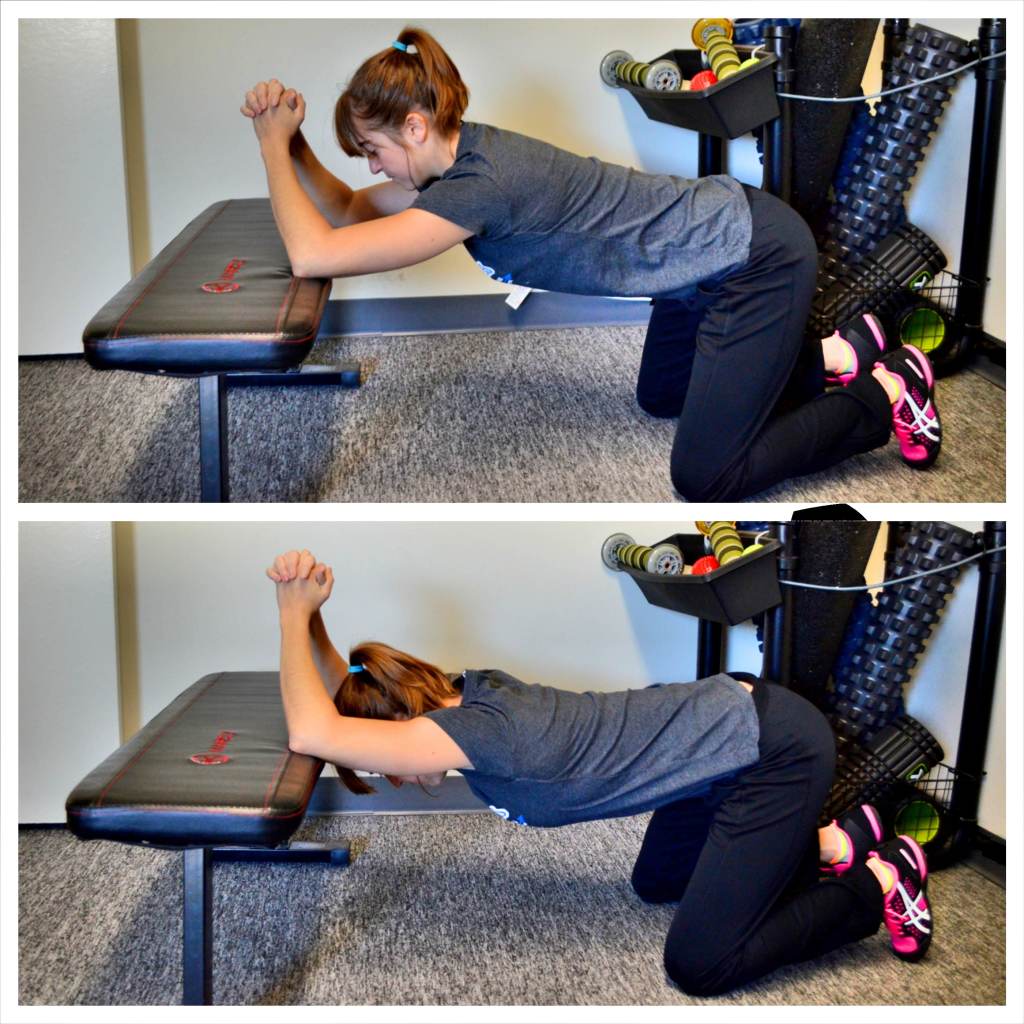
To do the Kneeling Thoracic Extension and Lat Stretch, place your elbows up on a bench about shoulder-width apart and kneel on the ground in front of the bench. Make sure you are back far enough that you have room to lean forward and over and drop your head between your elbows.
Then with your elbows on the bench, relax your chest and head over, sitting your butt back just slightly. Press your chest toward the ground and feel a nice stretch down your triceps and lats as well as through your thoracic spine. Try to extend your back as much as possible as you press your chest toward the ground.
You can either hold here and breathe to stretch deeper or you can come out of the stretch and then relax back into it and try to get further with each rep. If you’re using this as part of your warm up, perform reps instead of holding.
Just make sure you don’t simply ARCH your lower back to compensate which won’t help you stretch those lats!
Holding a dowel or towel between your hands to pull out on and to hold with your palms facing you (to put your shoulders into external rotation) can also be an added bonus to stretch everything out and improve your posture!
Straight Arm Shoulder Extensions:
This move will strengthen your lats as you work to improve your posture and your scapular mobility.
It’s also a great move to strengthen your posterior deltoid or the back of your shoulder.
If you sit all day, this is a great move to get your back working while working on a nice tall posture and wide shoulders…the opposite basically of how we sit all day!
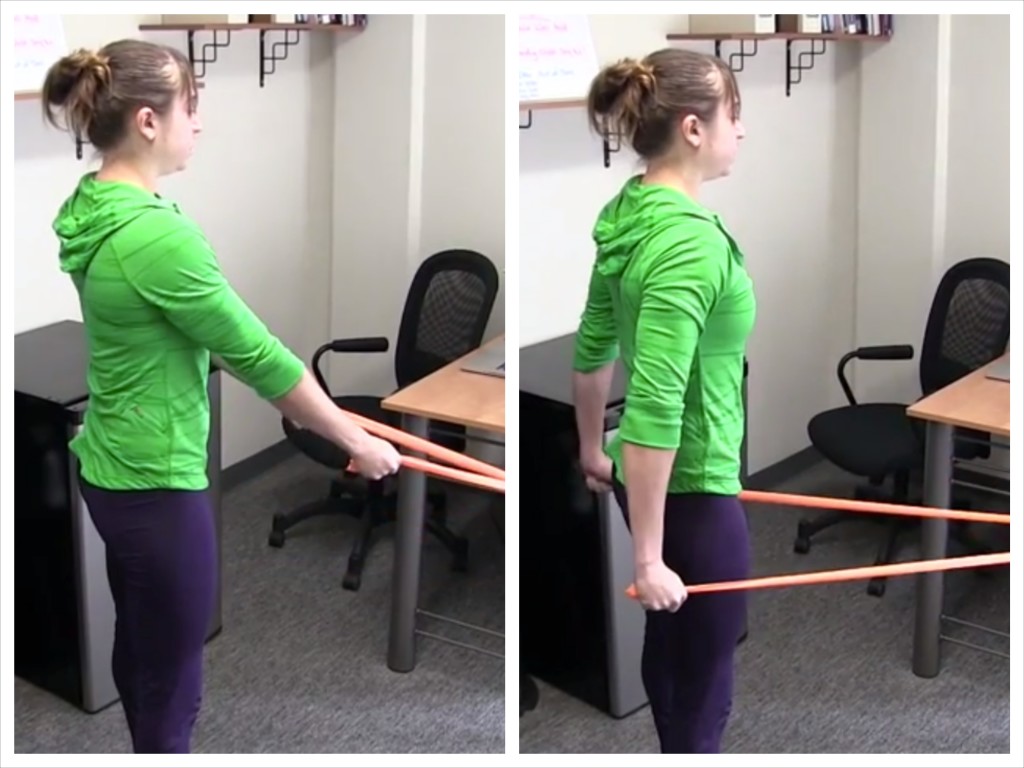
To do the Straight-Arm Shoulder Extension, anchor a resistance band below chest height and hold one end in each hand. You can grab with a neutral grip or even palms facing up to put your shoulder into external rotation.
Set up facing the anchor point but far enough away that there is tension in the band when your arms are down straight and your hands are in front of you. Stand up nice and tall with your feet about hip-width apart. Make sure you aren’t shrugging your shoulders and that your chest is pressed out. Think wide shoulders. Even feel the muscles between your shoulder blades already starting to engage before you even extend your arms back.
Keeping your arms straight and chest pressed out, pull back on the band, extending your shoulders as you pull your hands back toward your hips.
Feel your back and the backs of your shoulders extending your shoulder to pull the band back. You may even feel the back of your arm a little, but you shouldn’t feel your neck or upper traps at all.
Do not shrug as you pull back or jerk the band back and lean forward in an attempt to perform a bigger range of motion. Make sure your shoulders don’t just tilt forward to pull the band back further.
This won’t be a huge movement. Just focus on your back pulling the band back as your arms stay straight. Pinch your shoulder blades together as you pull back.
Hold for a second or two then relax your arms back forward and repeat.
Make sure you maintain a nice tall posture as you pull the band back. You must focus and think about your back working as you do the movement. Do not just go through the motions!
BONUS:
So a BONUS! move seemed appropriate since a potential culprit perpetuating lat tightness is weak glutes!
And because often ONE SIDE can become tight, it is key we have a unilateral glute activation move to address that!
The 80/20 Glute Bridge:
This move is a great way to isolate each side even if you’re not yet ready for the full single leg glute bridge, which is a very advanced bridge variation!
Plus, because of the band, this bridge will get your glute medius engaged and firing, which, in turn, will help your glute maximus fire better. WIN WIN!
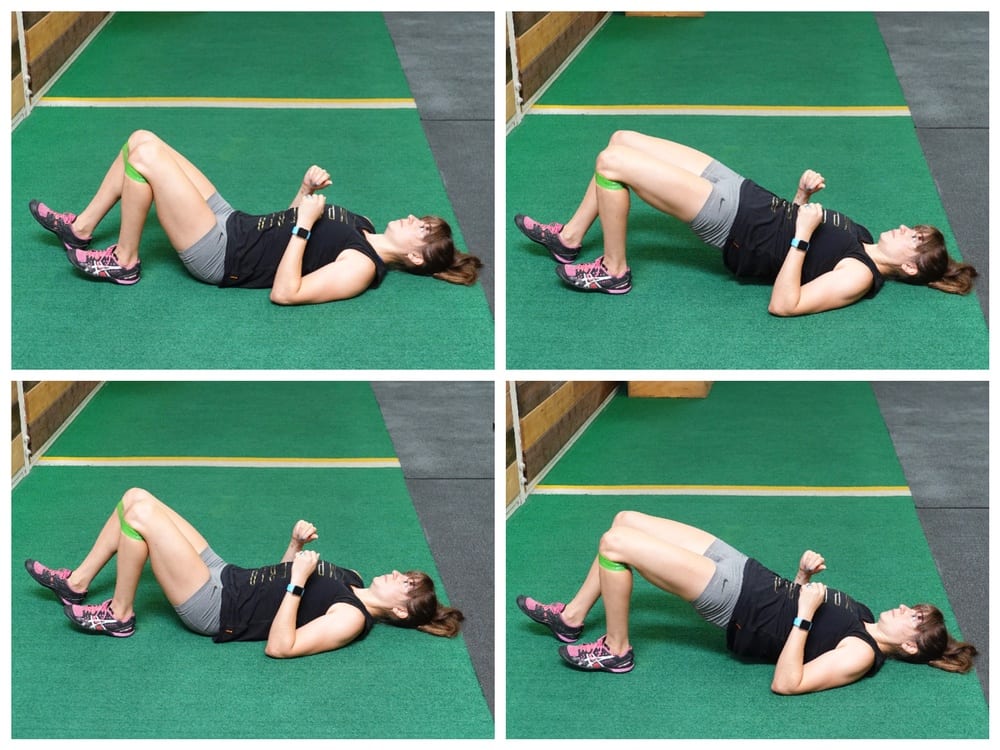
To do the 80/20 Glute Bridge, place a mini band right below your knees and lie on your back with your knees bent and feet flat on the ground. Then slide one leg out and away a bit from your butt and lift your toes. This foot should be about at the instep to toe of your other foot. Bend your elbows to 90 degrees and drive your upper arms into the ground. Posteriorly tilt your pelvis if needed then bridge up.
When you bridge up, you will be driving primarily off the foot flat on the ground, using the other foot for assistance so you can make sure to feel your glutes driving the move. Make sure your hips, knees and ankles all stay in line as you bridge up and lower down. Do not let your knees cave in with the band. Press out against the band the entire time.
Lower down and repeat the bridge on that side until all reps are complete. Then switch and move the other foot out, driving only through the heel so you can focus on bridging with your other side. This variation can help you make sure you can properly perform a more unilateral bridge!
Now…Are you ready to build a bulletproof body?
Get A Full-Body Program To Address All Your Mobility And Strength Needs:
The Arm Burner And Glute Camp Bundle!
